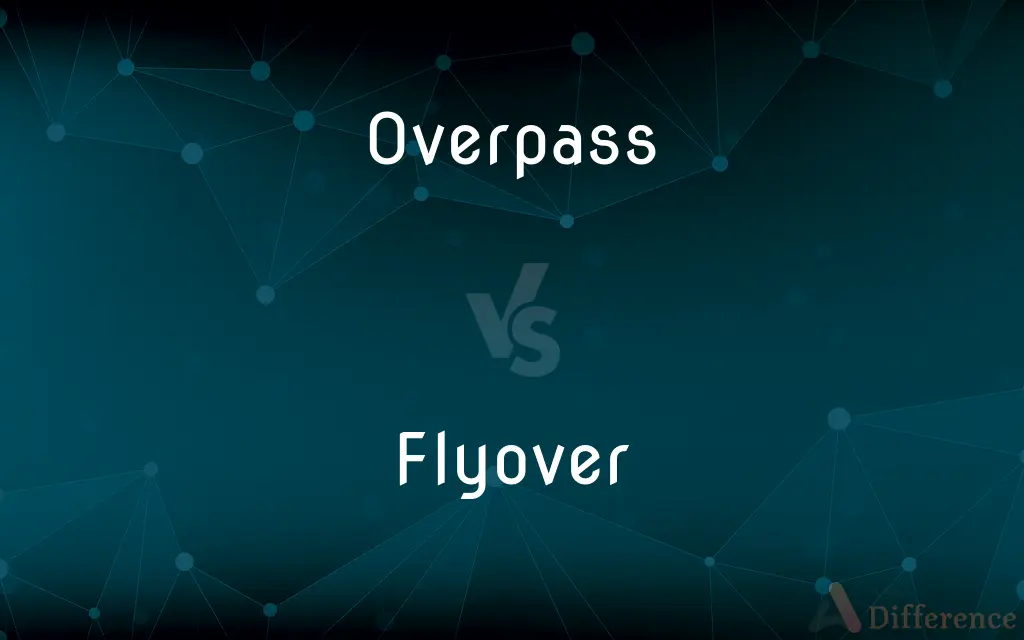Overpass vs. Flyover — What's the Difference?
Edited by Tayyaba Rehman — By Maham Liaqat — Updated on February 26, 2024
An overpass is a bridge that allows one road to cross over another, while a flyover is a specific type of overpass designed primarily for high-speed traffic, often seen on expressways.

Difference Between Overpass and Flyover
Table of Contents
ADVERTISEMENT
Key Differences
An overpass serves the general purpose of facilitating the crossing of roads, railways, or other obstacles without interfering with the traffic flow below. It's a broad term that encompasses structures designed for various types of vehicles, pedestrians, or trains. A flyover, conversely, is specifically engineered for vehicular traffic, particularly to manage high-speed vehicles on highways or expressways, aiming to reduce congestion at intersections or junctions.
Overpasses can be part of urban or rural road networks, supporting a wide range of speeds and types of traffic, flyovers are usually associated with urban infrastructure, where rapid transit is crucial. They are designed to keep traffic moving smoothly, especially in areas with high traffic volumes, and are a common sight in large cities.
The construction of an overpass might include designs that cater to pedestrians or bicycles, featuring stairs, ramps, or elevators, in addition to vehicular lanes. Flyovers, however, prioritize vehicular traffic, with designs focusing on seamless integration into high-speed roads, often without accommodations for non-vehicular traffic.
Safety features and architectural elements of overpasses can vary widely, reflecting the needs of the area they serve, including aesthetic considerations to blend with local surroundings. Flyovers, due to their focus on efficiency and speed, might have more standardized safety features aimed at high-speed traffic, with less emphasis on aesthetic integration.
The terminology used to describe these structures can vary by region, with some places using the terms interchangeably. However, the distinction generally lies in their purpose and design, reflecting the specific needs they meet within transportation networks.
ADVERTISEMENT
Comparison Chart
Definition
A bridge that allows one road to cross over another.
A type of overpass designed for high-speed vehicular traffic.
Purpose
Facilitates crossing over obstacles for various traffic types.
Reduces congestion, specifically for high-speed traffic.
Traffic Focus
Vehicles, pedestrians, trains.
Primarily vehicles on expressways or highways.
Location
Urban and rural areas.
Mainly urban areas.
Design
Can include pedestrian features.
Focused on vehicular traffic, minimal non-vehicular features.
Safety Features
Varied, depending on traffic type.
Focused on high-speed vehicle safety.
Aesthetic Considerations
May blend with local surroundings.
Less emphasis on aesthetics, more on efficiency.
Compare with Definitions
Overpass
Varied Design.
This overpass includes a bike lane for safer cycling routes.
Flyover
Urban Infrastructure.
The city's new flyover eases congestion near the downtown area.
Overpass
Aesthetic Integration.
The overpass features murals to reflect the community's culture.
Flyover
Standardized Safety Features.
High guardrails on the flyover prevent vehicular accidents.
Overpass
Crossing Structure.
The overpass allowed pedestrians to safely cross the busy highway.
Flyover
Efficiency Over Aesthetics.
The flyover's design focuses on traffic flow rather than landscape blending.
Overpass
Safety Features.
Lighting and barriers on the overpass enhance nighttime visibility.
Flyover
High-Speed Traffic.
The flyover significantly reduced commute times on the expressway.
Overpass
For Multiple Traffic Types.
The new overpass accommodates both cars and trains.
Flyover
Vehicle-Focused Design.
Designed without pedestrian paths, the flyover prioritizes cars.
Overpass
An overpass (called an overbridge or flyover in the United Kingdom and some other Commonwealth countries) is a bridge, road, railway or similar structure that crosses over another road or railway. An overpass and underpass together form a grade separation.
Overpass
A passage, roadway, or bridge that crosses above another roadway or thoroughfare.
Overpass
To pass over, away, or off.
Overpass
A road or other pathway which passes over another road, railroad, or other path; as, he stopped on the street under the railroad overpass.
Overpass
Bridge formed by the upper level of a crossing of two highways at different levels;
An overpass is called a flyover or a flypast in England
Common Curiosities
What is the primary function of an overpass?
To allow roads, pedestrians, or trains to cross over obstacles without disrupting traffic flow below.
Do all flyovers exclude pedestrian paths?
While primarily focused on vehicles, some flyovers may include pedestrian paths depending on the design and location.
Can the terms overpass and flyover be used interchangeably?
In some regions, yes, but there's a technical distinction based on their design and purpose.
Can overpasses accommodate pedestrians?
Yes, many overpasses are designed with pedestrian pathways, ramps, or stairs.
What materials are commonly used in constructing overpasses and flyovers?
Concrete and steel are typical due to their strength and durability.
How does a flyover differ from a standard overpass?
Flyovers are designed for high-speed vehicular traffic, often on expressways, with less focus on pedestrian access.
Why are flyovers important in urban areas?
They help manage traffic flow and reduce congestion in densely populated or high-traffic areas.
What challenges are associated with constructing flyovers in urban areas?
Space limitations, minimizing disruption to existing traffic, and environmental impact are common challenges.
How does the design of a flyover affect traffic flow?
It's optimized to keep high-speed traffic moving smoothly, reducing bottlenecks and improving overall flow.
What role do aesthetics play in the design of overpasses and flyovers?
Overpasses may include aesthetic elements to blend with local surroundings, while flyovers prioritize functional design.
How do overpasses and flyovers impact urban planning?
They are crucial for efficient traffic management, influencing the development and accessibility of urban areas.
How do engineers decide whether to build an overpass or a flyover?
The decision is based on traffic needs, speed requirements, and location characteristics.
How are safety features on overpasses and flyovers different?
Safety features are tailored to the types of traffic each structure supports, with flyovers focusing on high-speed vehicular safety.
Are there environmental considerations in building overpasses and flyovers?
Yes, both must consider environmental impact, but the extent varies by project and location.
Can overpasses and flyovers be retrofitted to improve safety or aesthetics?
Yes, they can be upgraded or modified to enhance safety features, pedestrian access, or visual appeal.
Share Your Discovery

Previous Comparison
Cleats vs. Spikes
Next Comparison
Mayo vs. MayonnaiseAuthor Spotlight
Written by
Maham LiaqatEdited by
Tayyaba RehmanTayyaba Rehman is a distinguished writer, currently serving as a primary contributor to askdifference.com. As a researcher in semantics and etymology, Tayyaba's passion for the complexity of languages and their distinctions has found a perfect home on the platform. Tayyaba delves into the intricacies of language, distinguishing between commonly confused words and phrases, thereby providing clarity for readers worldwide.















































